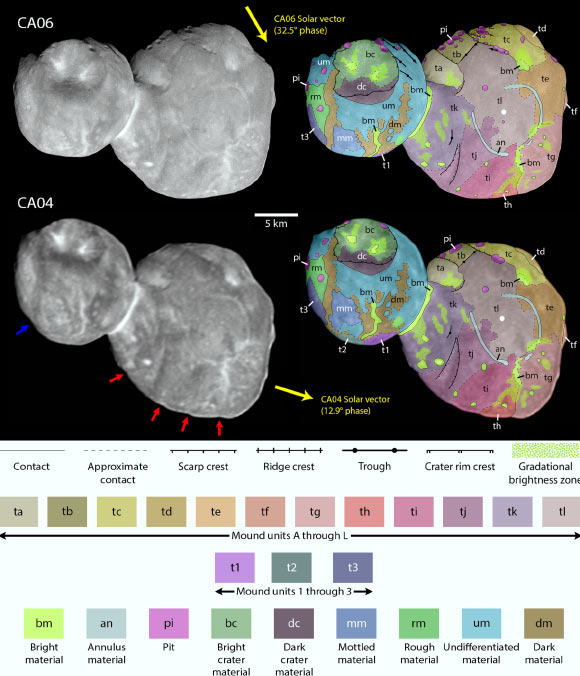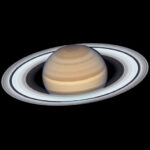The 5-km-long mounds that dominate the appearance of the larger lobe of Kuiper Belt object (486958) Arrokoth are similar enough to suggest a common origin, according to new research.
New Horizons mosaics of Arrokoth (left) and the same observations overlain with geologic mapping (right). Image credit: Stern et al., doi: 10.3847/PSJ/acf317.
As a result of a flyby by NASA’s New Horizons mission on January 1, 2019, Arrokoth became the first and remains the only Kuiper Belt object to be studied in detail by any spacecraft (e.g., Stern et al. 2019).
Also known as Ultima Thule or 2014 MU69, it is a contact binary Kuiper Belt object, consisting of two bodies (referred to as ‘lobes’) that apparently gravitated toward each other until they bonded.
Among the most striking geologic features on the surface of Arrokoth is the ensemble of large, broadly similarly sized mound-like features seen on the larger lobe, Wenu.
From the New Horizons data, Southwest Research Institute planetary scientist Alan Stern and colleagues identified 12 mounds on Wenu, which are almost the same shape, size, color and reflectivity.
They also tentatively identified three more mounds on the object’s smaller lobe, Weeyo.
“It’s amazing to see this object so well preserved that its shape directly reveals these details of its assembly from a set of building blocks all very similar to one another,” said Lowell Observatory researcher Will Grundy.
“Arrokoth almost looks like a raspberry, made of little sub-units.”
Arrokoth’s geology supports the streaming instability model of planetesimal formation where collision speeds of just a few miles per hour allowed objects to gently accumulate to build Arrokoth in a local area of the solar nebula undergoing gravitational collapse.
“Similarities including in sizes and other properties of Arrokoth’s mound structures suggest new insights into its formation,” Dr. Stern said.
“If the mounds are indeed representative of the building blocks of ancient planetesimals like Arrokoth, then planetesimal formation models will need to explain the preferred size for these building blocks.”
There is a good chance that some of the flyby targets for NASA’s Lucy mission to Jupiter’s Trojan asteroids and ESA’s comet interceptor will be other pristine planetesimals, which could contribute to the understanding of accretion of planetesimals elsewhere in the ancient solar system and whether they differ from processes New Horizons found in the Kuiper Belt.
“It will be important to search for mound-like structures on the planetesimals these missions observe to see how common this phenomenon is, as a further guide to planetesimal formation theories,” Dr. Stern said.
The results are published in the Planetary Science Journal.
_____
S.A. Stern et al. 2023. The Properties and Origin of Kuiper Belt Object Arrokoth’s Large Mounds. Planet. Sci. J 4, 176; doi: 10.3847/PSJ/acf317




